Granaries
Edward Green
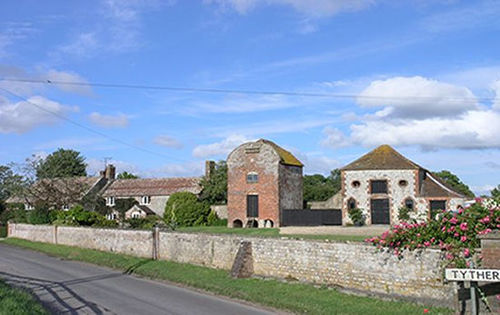 |
|
| An unusual brick granary at Tytherington, Wiltshire. It boasts brick arches over piers and an elegant Dutch gable doubling as a dovecote. |
The revolution in English agriculture, which took place from the mid-1700s, had a dramatic effect on the landscape of the countryside. In particular the enclosure of large spaces of open land enabled crop production to be substantially increased to meet the demands of the rapidly growing population. As well as having a major influence on the landscape, enclosure and the introduction of new farming practices also contributed to England’s stock of farm buildings. New buildings were required to accommodate stock and equipment on the new model farms. They were also needed for the storage of grain. Most of the surviving granaries date from the time of Enclosure – the late 18th early 19th centuries.
HISTORY AND CONSTRUCTION
Granaries are farm buildings which were specifically designed for the long-term storage of grain, particularly seed grain. According to Brunskill (see Recommended Reading), there are four main types of granary; the free-standing granary, the granary raised over a cart shed, the granary raised over a stable and the granary combined with food preparation. This article will concentrate on the first of these types, which are found throughout the south of England, from Cornwall to Suffolk.
TYPES AND VARIATIONS
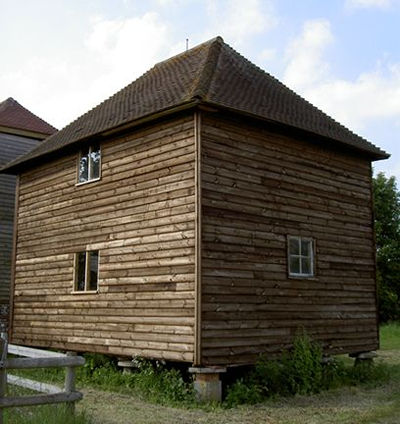 |
||
 |
 |
|
 |
||
| A double storey granary at Fosbury with modern windows and cladding. Hidden inside is a remarkable interior complete with grain bins and chutes. | ||
Free-standing granaries are typically square, single-storey timber-framed structures. Exterior walls are usually weather-boarded, tile- or slate-hung, or with panels of brick-nogging. Roofing materials vary from thatch to slates, stone tiles or pan tiles, although the hipped pyramidical roof is most common. Some early granaries rested on wooden posts, but from at least the early 1600s a grid of staddlestones or brick piers was used tosupport the structure and to keep the grain dry and out of the reach of vermin. Hollowell states that the word staddle is derived from either stathol (Saxon), stadal (Old High German), stothull (Old Norse), or stathlaz (Germanic), all of which mean a stand or base.
Staddlestone granaries are most common in the main arable areas of central southern England (over half are found in Oxfordshire, Wiltshire, Berkshire and Hampshire) where the limestone is relatively soft and easily carved. Carved limestone staddlestones are most common, although brick piers were sometimes used instead. There are also later examples of staddles made from cast iron. The staddlestones raise the granary approximately 600mm off the ground. The sides of their posts and the underside of their projecting caps are smooth, so that they cannot be climbed by rats or mice. They also provide firm support for the granary’s stout floor beams, both designed to bear the heavy weight of the grain being stored.
The design of these granaries also satisfy a number of other vital requirements. After harvesting, corn continues to respire, taking in oxygen and giving out both carbon dioxide and water. This moisture posed a major threat to the stored grain, as damp conditions could cause either premature germination or mildew. The ventilation provided by air beneath the floor of the granary helped prevent either of these two problems from occurring. Inside, the grain was stored in sacks or bins to reduce its bulk, further helping it to dry out.
A third problem was theft. Although grain was best kept dry by storing it in sacks, these were easier to steal than loose grain. In this respect, bins were preferred, and granaries were always kept locked. The free-standing granary in the centre of the farmyard also offered the advantage over other forms of granary that the farmer could keep it under surveillance. Wiliam remarks that grain stored over cartsheds was easy prey for waggoners, who would make discreet holes in the loft floorboards to steal grain for their horses.
The grid pattern of staddlestones on which the free-standing granary rested was typically 12 stones arranged four by three, although the designs of the granaries ranged considerably, as shown by the photographs. Many were square, single storey buildings, but some were large rectangular buildings of two storeys or more. The granary at Tytherington, Wiltshire, for example, is entirely of brick with brick arches over piers and an elegant Dutch gable doubling as a dovecote.
Moving from the base of the granary to its roof, the shape of this was also designed for a specific function. Usually pyramidal, hipped or half-hipped, the shape of the roof assisted access into the granary, for farm labourers having to carry heavy sacks. The main entrance to the granary was typically reached with the use of removable wooden steps. Permanent steps would have given rodents easy access to the grain. Similarly, the nuisance of birds getting at the grain was prevented by the use of grilles or shutters over any window openings included.
Inside, the walls were smooth, either lined with close-fitting boards or plastered and limewashed. In many, the bins still survive. Those with upper floors often had chutes with simple wooden traps through which the grain could be poured into sacks below.
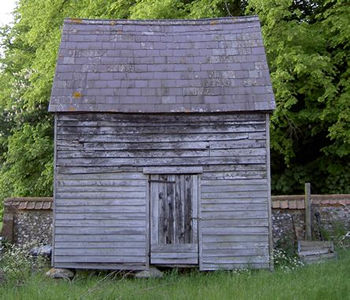 |
|
| This typical small staddlestone granary shows timber boarding over timber frame. |
DECLINE AND REDUNDANCY
Improvements in transportation during the second half of the 19th century brought about a substantial increase in the importation of food, and grain in particular from North America, Australia and other British colonies. The mass exodus from the countryside to the cities was a product of this decline as much as of the rise of industry, but it also fuelled the crisis. According to Harvey, in the 1870s 75 per cent of British food was indigenously produced, but by 1925 this had fallen to 25 per cent. The greatest impact was on arable production, as meat and dairy produce remained relatively protected from the worst affects of the recession until the development of refrigerated transportation. This decline had a huge detrimental impact on farm buildings associated with arable production. Many fell into disuse and, with the emergence of larger arms and increasing mechanisation in the 20th century, were in any case inadequate for new methods of farming.
Small, free-standing granaries were among the first agricultural buildings to be made completely redundant. Their small size made them suitable stores for small tools and other items that could be carried up the steps, but little else. Like many other agricultural buildings, the cost of repairing and maintaining them through the 20th century far outweighed their economic benefit, and the number of isolated staddlestones now used as odd garden ornaments provides a reminder of the numbers which have been lost. Yet many complete staddlestone granaries have survived: 743 examples are listed on Images of England, the on-line database of listed buildings.
The survival of so many mainly Georgian and early Victorian granaries after over 150 years of redundancy is remarkable, and is perhaps due to the superb quality of their construction, their small size and their character. Designed to protect one of the farmer’s most valuable assets, their raised construction has helped to ensure that they have remained both well ventilated and relatively dry. Nevertheless, they remain a threatened feature of the landscape. Few farmers can afford to maintain their historic buildings, and most of these granaries remain too small for any viable economic use.
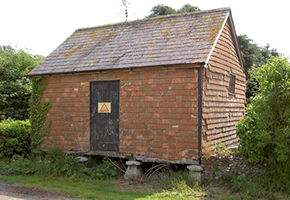 |
|
| A
timber framed granary at Ramsbury, Wiltshire, once used as a book store by Oswald Moseley. |
|
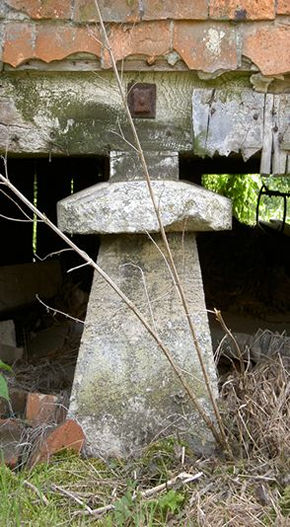 |
|
| A detail of one of its staddle stones. Movement has caused the brickwork infill panels to become detatched, as seen by the bow in the gable wall, and the roof has been replaced with asbestos slates. However, beneath the clay tile hanging and the superficial disorder, its early 19th century timber frame still appears sound. |
CONSERVATION
Almost all free-standing granaries which survive in anything like their original condition are listed. Usually they will be listed as individual buildings, but they will also be protected if they fall within the ‘curtilage’ of a listed building (all the buildings in the farmyard of a listed farm may thus be protected), and listed building consent would be required before one could be moved, altered or demolished. Furthermore, if the building is left to rot away, the local authority has the power to intervene and, if necessary, can carry out emergency works to keep the building wind and weather tight, and then recover the cost from the owner.
Moving a building away from its original location is generally considered when the only other option is demolition, because the setting is a vital element of its history and, therefore, its value. Moving a building to a new location distorts its history and in the worst case a particularly incongruous location may create the impression that the building is a fake. Also, the significance of the farmyard itself must be taken into account, and the loss of such an important building could be considerable.
Alterations which are necessary to enable a new use for a building are, in principle, much more likely to be acceptable to the local authority. There are many examples of granaries which have been converted to provide a small office or games room, and the result can be delightful.
Apart from the sensitive design of fenestration, the most difficult element of a conversion is often insulation, as there is a risk that this may prevent the structure breathing, and may introduce condensation within the walls and roof timbers of a timber framed structure, causing the timbers to decay. The relationship of the insulation to the vapour barrier must be considered carefully, since if the vapour barrier is on the cold side of the insulation, or a cold spot occurs, condensation will develop and run down the material. If condensation occurs within the insulation, the insulation will become soaked, again causing timbers to decay.
REPAIRS
As with any building, neglect, lack of maintenance and inappropriate repairs can result in structural failure. For example if brick infill panels of a timber frame have been pointed with a hard cement-rich mortar, the mortar will prevent the walls moving with the natural expansion of the frame, causing damage to either the frame or the brick, or both. The cement also traps moisture, causing the frame to rot. Traditional mortars based on lime and sand are more flexible and porous than modern cement mortars.
One of the most serious problems concerning the conservation of granaries relates to their foundation on the staddlestones. The uneven settlement of individual staddlestones has a knock-on effect for the flooring and walls of the building. Structural cracks can develop, threatening the stability of the structure.
This differential settlement of the staddlestones can be exacerbated by excessive water from a broken gutter or the position of a down pipe. Yet it is not just water from the granary itself that can cause problems. Water from adjacent buildings and surface drainage that flows in the direction of the granary will soften the ground around the staddlestones.
The problems posed by granaries and by alterations such as the introduction of insulation are unlikely to be insurmountable, but as with all historic building work, the alterations and their consequences must be carefully thought through. Employing a specialist architect or surveyor for such a small project may sound excessive, but the additional cost will be commensurately small, and cutting corners in this area can be disastrous. Likewise, where historic brickwork and traditional timber framed structures are concerned, employing a specialist contractor who understands the use of traditional materials such as lime mortar and oak framing is essential. These projects cannot simply be left to an ordinary builder.
Recommended Reading
-
RW Brunskill, Traditional Farm Buildings of Britain and their Conservation, 3rd edition, Victor Gollancz, London, 1999
-
Nigel Harvey, A History of Farm Buildings in England & Wales, David & Charles, Newton Abbot, 1970
-
Stephen Hollowell, ‘Staddle Granary; Parkhill Farm, Castle Ashby, Northamptonshire’, The Journal of the Historic Farm Buildings Group, Volume 12, 1998
-
Pamela M Slocombe, Wiltshire Farm Buildings 1500-1900, Devizes Book Press, Devizes, 1989
-
Eurwyn Wiliam, Traditional Farm Buildings in North East Wales 1550-1900, Welsh Folk Museum, Cardiff, 1982



